
Hyster Loaded Container Handlers Fort Worth
In order to help avoid the requirement for expensive lift truck repairs, it is suggested to check the front end of your forklift frequently as part of your daily and even pre-shift examination. By catching any problems in advance or as they occur, you could also help prevent damage to any loads as well. The following includes several of the general guidelines on what specific things to inspect during frequent inspections of your material handling fleet.
Forks
It is essential to regularly inspect the forks because if they are worn out or cracked, they can potentially fail without warning. Any kind of fork damage means that your forklift must immediately be removed from service until it is fixed and safe once more. Visually check your forks for any noticeable indications of damage or wear. If the cracks run deeper than on the surface, replace them. Any kind of wear on the forks beyond 10 percent is one more indication that you must replace the forks.
Mast
Ideally, the mast should tilt forward and back and be able to smoothly move down and up. If you find that the sliding surfaces are binding, you might have to grease the mast strip sliding surfaces as well as their fittings. On the inner mast there is a fitting situated on every side. The lift bracket side rollers are another lubrication point and there is also one on each side roller. When the lubricating has been completed, raise and lower the mast and also tilt it backward and forward several times in order to make sure that the lubricant is worked properly into the fittings.
Tilt Cylinders
Your daily inspection has to include the checking for damage and oil leaks since an uncontrolled mast movement can be caused by oil leakage. Whether the leaks are situated inside of the cylinder or are external, the end result could be loss of fluid and cylinder drift. If there are any indications of damage or leaks, you may need to replace just the seals or the entire cylinder assembly.
Chains
Check and make sure that the mast chains are not stretching beyond their acceptable limits. Also be certain to check the chains for indications of wear or damage using a chain wear gauge. If wear is present beyond 2 percent, replace the chain. Also replace it if the chain appears rusted or kinked. The sheave bearings and the chain rollers must also be checked for indications of wear.
Usually, mast lift chains wear at the pin-to-link connections. If you discover wear, you can experience chain failure. This could end up damaging front end parts or even the product. If you need help determining what exactly to check on your forklifts or if you do not have time on hand to carry out regular fleet inspections, just call your local forklift dealer. Their skilled service technicians will help your perform PM or planned maintenance checks according to your scheduling and application needs.
- Fantuzzi Container Forklift Fort Worth
Rail / Intermodal Reach Stacker Rail or Intermodal Reach Stackers manufactured by Fantuzzi would make fast work of difficult applications. The distances between the first and second rail will drastically vary depending on the task.... More - Taylor Rough Terrain Forklift Fort Worth
Rough Terrain Lift Truck Training Class VII or rough terrain forklifts are often used in logging and forestry projects and are common on construction sites. They are the popular option for outdoor settings which depend... More - JCB Zoom Boom Fort Worth
Raw Materials The cab, body, boom and frame of a telescoping boom rough terrain forklift are generally manufactured by a lift truck manufacturer. The most common material used for these subassemblies is steel, because of... More - Potain Self Erect Cranes Fort Worth
Tower cranes are being utilized often for big building construction projects. They are necessary for the heavy lifting and positioning of materials and machinery. Tower cranes provide a different design that offers a lot of... More - Yale LP Forklifts Fort Worth
You'll notice specific types and classes of forklifts available on the market. Once you have become familiar with the numerous models, it is easier to understand you lift truck application needs prior to choosing one.... More








